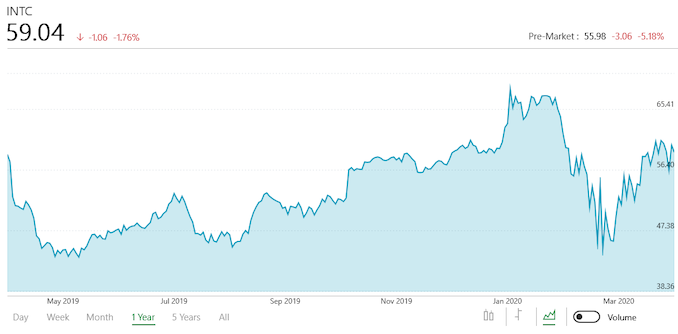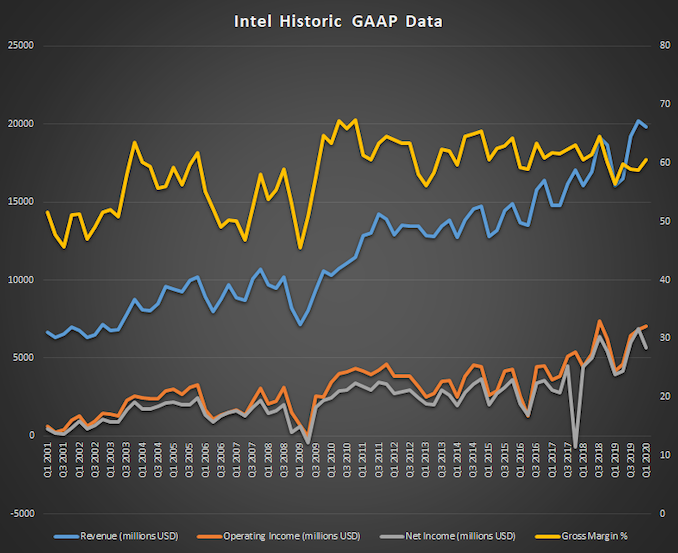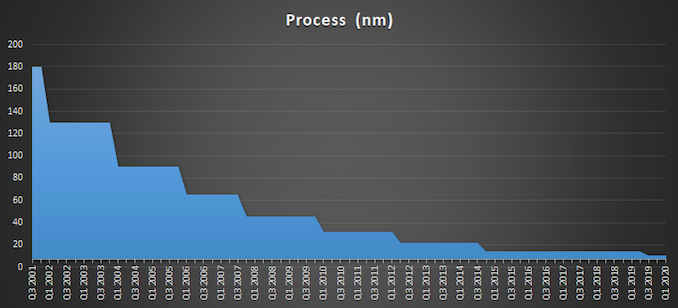Intel Reports Q1 2020 Earnings: Another Strong Quarter For Both Client and Datacenter
by Ryan Smith on April 24, 2020 9:30 AM EST- Posted in
- CPUs
- Intel
- Financial Results

Kicking off earnings season for the tech industry, Intel yesterday evening reported their financial results for the first quarter of the year. And, like pretty much every Intel quarter for the last couple of years, it was a doozy, with Intel once again recording growing revenues and a very healthy profit margin.
For the first quarter of 2020, Intel reported $19.8B in revenue, a significant improvement over the year-ago quarter, and only slightly behind Intel’s record-breaking Q4. As a result of this strong revenue, income was also very healthy for the company, with Intel recording $5.7B in net income, a 43% jump over Q1’19. Meanwhile gross margins were up 4 percentage points to 60.6%, pushing Intel back above their much revered 60% gross margin threshold.
| Intel Q1 2020 Financial Results (GAAP) | |||||
| Q1'2020 | Q4'2019 | Q1'2019 | |||
| Revenue | $19.8B | $20.2B | $16.1B | ||
| Operating Income | $7.0B | $6.8B | $4.2B | ||
| Net Income | $5.7B | $6.9B | $4.0B | ||
| Gross Margin | 60.6% | 58.8% | 56.6% | ||
| Client Computing Group Revenue | $9.8B | -2% | +14% | ||
| Data Center Group Revenue | $7.0B | -3% | +43% | ||
| Internet of Things Revenue | $1137M | -2% | +8% | ||
| Non-Volatile Memory Solutions Group | $1.3B | +8% | +46% | ||
| Programmable Solutions Group | $519M | +3% | +7% | ||
Breaking things down on a group basis, many of Intel’s internal reporting groups saw double-digit growth over the year-ago quarter. Client computing revenue was up 14% to $9.8B, and data center revenue was an even bigger winner with $7.0B in revenue, a 43% jump over the previous year. The significant growth in the data center segment comes as Intel saw both higher average selling prices and higher volumes overall, with ASPs and volumes growing by 13% and 27% respectively. Overall Intel attributes the data center gains to the company’s “broad strength” in the market, though they did note that they’ve seen a 53% year-over-year increase in revenue from cloud service providers.
As for client computing revenue, the biggest gains there came from notebook ASPs, which were up 22% over the year-ago quarter. Other client metrics were relatively tame; notebook volumes actually slipped 3%, while on the desktop, ASPs were up 4% while volumes were down 4%. For Intel’s client group, the company is coming off of the second quarter of selling Ice Lake laptops, with improving supply and improving helping to drive those numbers. As well, Intel’s new Comet Lake-H CPUs were recently launched, which means those would have been shipping to OEMs in Q1 as well.
Rounding out Intel’s product portfolio, the company recorded smaller gains for their Programable Solutions Group, as well as their Internet of Things business. Overall IoT was a mixed bag: Mobileye revenue, which the company offers a separate breakout, was up 22% over the previous year, but the rest of Intel’s IoT business saw a 3% drop in revenue. Finally, Intel’s storage group was a surprising winner, with record revenue pushing them to year-over-year growth of 46%, thanks to higher NAND ASPs and lower unit costs.
Meanwhile, like most other tech companies, the 800lb gorilla of the chipmaking world finds itself in an interesting position as the novel coronavirus pandemic has shuttered large parts of the world’s economies. For Q1, Intel believes they actually benefitted somewhat from the outbreak, as companies and consumers needed to make previously-unplanned purchased of laptops and other equipment for working from home and remote learning. However as the pandemic continues, it’s likely to start impacting Intel’s sales in other ways, as idled business won’t be making their usual purchases and expansions. As a result, Intel isn’t even providing full-year financial guidance due to the economic uncertainty that the pandemic has caused.
On the flip side of the coin, as a business and employer themselves, the coronavirus outbreak has also threatened Intel’s manufacturing operations. Despite that, according to Intel the company was able to keep all of its essential manufacturing operations going, with an on-time delivery rate that’s still better than 90%. So thus far Intel seems to have weathered the first part of the pandemic fairly well.
All eyes then will be on the second quarter, both for continuing developments with the coronavirus pandemic, as well as Intel’s own internal manufacturing efforts. With Intel set to start shipping its 10nm Tiger Lake CPUs to OEMs by mid-year, the company is going to be pushing its 10nm manufacturing lines harder than ever as they ramp up for a new generation of CPUs. While slowly improving, 10nm’s rocky bring-up remains a bit of a proverbial albatross around Intel’s neck, so further improving capacity and yields will go a long way towards helping Intel maintain its success, especially in light of heavy competition from AMD.
Source: Intel












49 Comments
View All Comments
Spunjji - Tuesday, April 28, 2020 - link
"All these issues and still they can't even give away their Epyc line..."Almost like there's more to it than just who has the best equipment, no? Almost like things are a little more complicated than that...
Even when you're responding to an obvious fanboy, you still come across as the bigger tool. "cheap chinese knockoff AMD" indeed. You're a bargain-basement discount shill.
JayNor - Friday, April 24, 2020 - link
AMD just now getting a laptop chip that competes with Ice Lake, but Intel jumping out ahead with Tiger Lake deliveries this summer.Intel seems not too worried about competing with AMD on desktop with their Comet Lake 5GHz+ chips.
Ice Lake Server chips sampling, according to CC ... adding 8ch memory, PCIE4, Sunny Cove cores ... might be a surprise to some that Intel's 10nm high performance processing is different than their 10nm low power processing used for laptops.
duploxxx - Friday, April 24, 2020 - link
if you can still wait at least 6 months for the paper launch Ice Lake and hope devices will be available... with 32-36 cores in a +2xxW packagejust like the cascade lake R release with 2 months delay in shipping.
Deicidium369 - Saturday, April 25, 2020 - link
Sorry, Kiddie - Ice Lake Xeon is already sampling to large customers - look for it in Q3. and upto 38 cores, I know reading is hard for you.Hard to bury a well worn meme - with Ryan and the Albatross and all this heavy competition from AMD - truth is 10nm and 10nm+ are in full production, and about to blot out the sun like Core did well over a decade ago
Spunjji - Tuesday, April 28, 2020 - link
"10nm and 10nm+ are in full production, and about to blot out the sun like Core did well over a decade ago"🤣 Even if this were true - and it very obviously is not - 10nm firing on all cylinders would put them on a fairly even footing with AMD, maybe even a narrow victory (maybe). You sure do know how to ruin a response with an absurd overstatement. Fanboy logic...
haukionkannel - Friday, April 24, 2020 - link
Intel is selling like hotcakes!Amd is not ever near in how much cpus these companies sell...
So Intel knows that They don`t have to reduce prices! People still buy their products more than AMD... it is not easy to battle against Intel...
Deicidium369 - Saturday, April 25, 2020 - link
Would have thought will all the huge massive problems Intel has (according to the kiddies) that AMD would have been able to capitalize on those issues.Intel is a known quantity, and AMD is NOT a drop in replacement for Intel.
Spunjji - Tuesday, April 28, 2020 - link
You answered your own conundrum. AMD can't capitalise on missteps by a competitor in a market to which they don't yet have unfettered access.I get the impression you'd have been out there shilling for P4-derivative Xeons against Opteron back in 2003, too.
Lord of the Bored - Monday, May 4, 2020 - link
He probably wasn't old enough to be on the internet back in 2003.Korguz - Monday, May 4, 2020 - link
actually, on a different site, he claimed that he retired @ age 28, 20 years ago, and yet on another thread on the same site, he claimed he started a woodworking business 40 years ago. so that could mean he was 28 in 2000, and at the age of 8, started his wood working business, which would put him at being 8 years old around 1980.